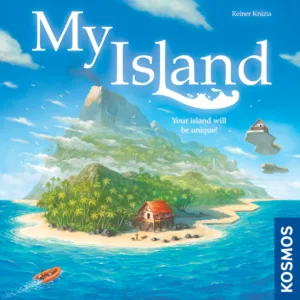 Have you ever wanted to experience the rush of exploring an uncharted island that—depending on how you interpret the flimsy narrative of the game—has either been inhabited, then forgotten multiple times over the course of hundreds of years or never before touched by human hands? Have you ever wanted to take that theme and play a game based on it 24 consecutive times with almost no interesting changes to the ruleset or goals?
Have you ever wanted to experience the rush of exploring an uncharted island that—depending on how you interpret the flimsy narrative of the game—has either been inhabited, then forgotten multiple times over the course of hundreds of years or never before touched by human hands? Have you ever wanted to take that theme and play a game based on it 24 consecutive times with almost no interesting changes to the ruleset or goals?
Yeah, me neither. But here we go anyway.
My Island is a competitive(ish) and legacy(ish) game for 2 to 4 players designed by Reiner Knizia. It lasts 24 games spread across 8 “themed” Chapters and each Episode plays in just about a half hour. While not resettable, the game technically can be played forever at the conclusion of the campaign.
Gameplay Overview:
My Island is a tile-laying legacy game in which players will all use the same shaped tile each turn and add it to their (potentially) unique island grid. Scoring varies depending on the Chapter players are on, but for the most part, it involves clustering like terrain types together or making paths from one point to another. Winning each individual game (an “Episode” in the game’s parlance) offers a reward that will help a player win the long-term legacy game itself.
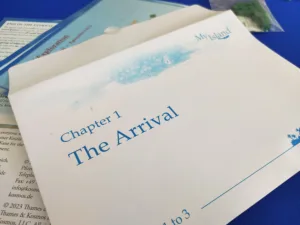
The rules at their most basic are standard tile stuff—certain spaces need to be covered, tiles need to be placed adjacently to like terrain, etc.—but get more involved and complicated as the campaign progresses. Well… they kinda do; more on that later.
The structure of My Island overall is that there are 8 Chapters, each divided into 3 Episodes. The game doesn’t technically reset at the end, although in the rulebook it is explained that each individual Chapter is meant to be replayable as a standalone game once the campaign is over. (Frankly, I’m not sure how some of these can be easily played standalone, but that’s what the rulebook says.)
It’s difficult to say too much about the way the game changes without spoiling the legacy stuff, but it should come as no surprise that stickers will be added, new scoring options will pop up, and wackiness will ensue.
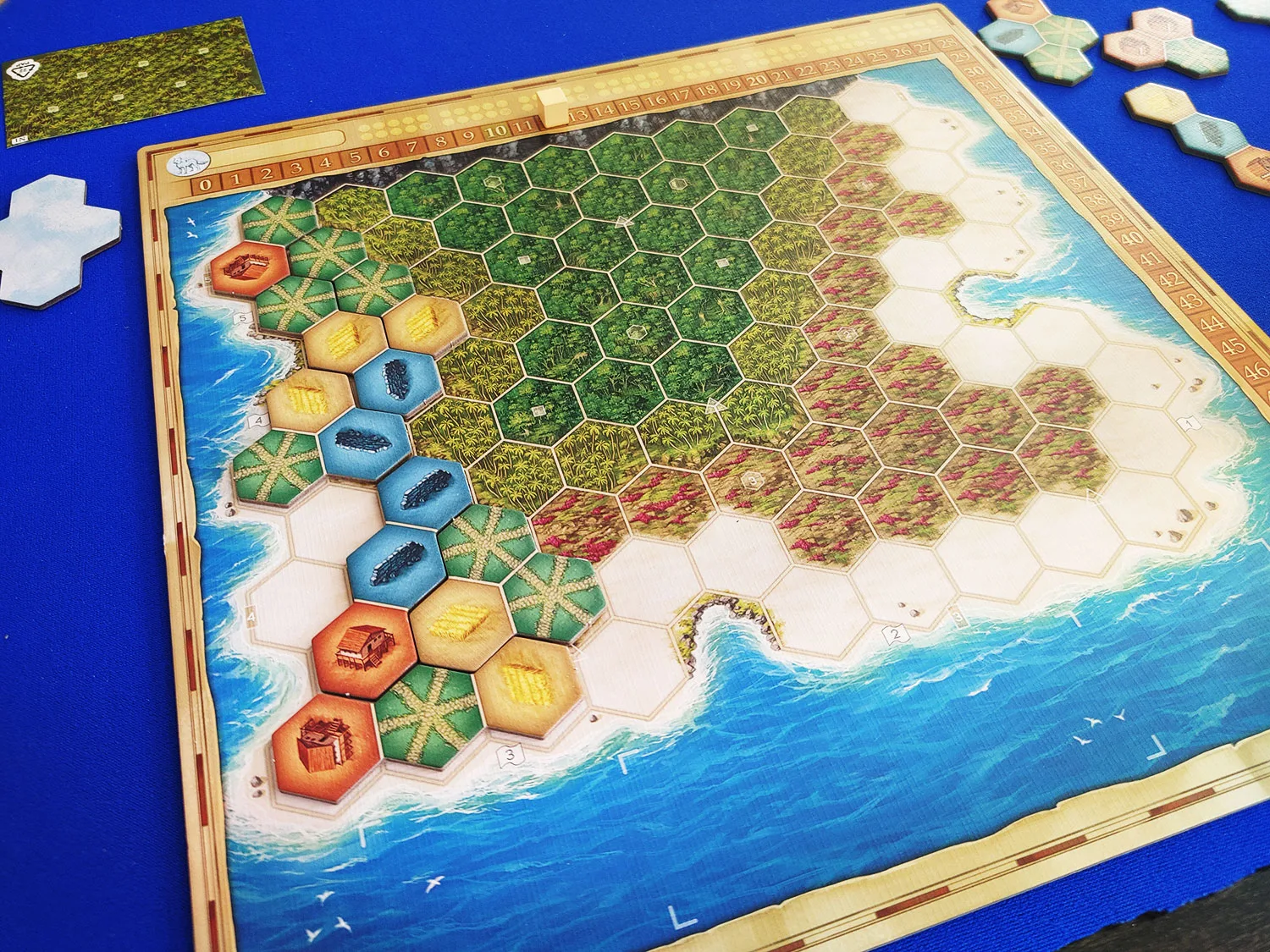
Game Experience:
As a fan of Herr Doctor Reiner’s work, I was cautiously optimistic that a legacy game of this type would prove to be streamlined and inventive in the way some of his best games are. And the early chapters of My Island do seem to be headed in that direction with simple but enjoyable mechanisms and a fun—albeit slow—progression of complicating factors.
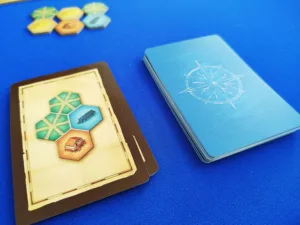
There’s a point, however, when it becomes clear that every episode is simply a slight variation on a relatively thin theme. (For me, that point was Episode 7. I decided I was done with the game and ready to write my review, but realized I still needed to play 17 more games before Board Game Quest’s head honcho Tony Mastrangeli would deem me knowledgeable enough about the experience for publication.) Some of the mechanical progression is logical—for instance, blue clusters increasing in value during a specific Chapter—while others are just there to seemingly give the illusion of a campaign experience.
The game also swings wildly from simple to the point of boredom to “now there’s 12 different new rules to play this round.” Sometimes these jumps occur one game after the other, making the progression so rapid that it’s confusing to keep track of what has changed from just the previous game. Along these same lines: the rulebook is a mess. The main rulebook obviously doesn’t say a whole lot to begin with and then the remainder of the rules are laid out in each Chapter’s envelope as you reveal them. For the most part, the rules are basic enough that experienced gamers will be able to figure them out. Often, however, a rulesheet will say, “All previous rules apply,” but then in the recap section it won’t list a bunch of previous rules that should apply. This really bugged me at first. And then Episode 7 rolled around and, like I said before, I kinda stopped caring and went with my best instincts.
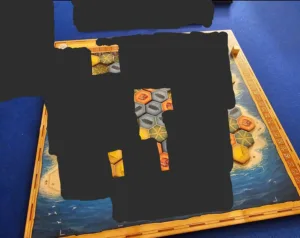
As a last general point on the game, I should say that it’s never terrible. Puzzling out the best way to surround an object or create a path is mostly charming and the obstacles the game presents are all fun(ish) to contend with. It just never feels like anything is actually changing. Sure, the sticker you’re trying to avoid (or, occasionally, not avoid) might have a different cartoony drawing on it, but it never seems to be different from any of the other stickers you were presented with 6 Episodes ago. That’s the game’s biggest problem, ultimately. Legacy games are popular for not just the variety of play they offer, but also for those moments where something happens that causes everyone at the table to look around and say, “This game is now an experience.” My Island doesn’t feel like an experience and, frankly, sometimes doesn’t even feel like a game.
Final Thoughts:
It pains me to come down so hard on this one. I’m of the opinion that Reiner Knizia can’t design a truly bad game and that’s still the case here. My Island has some charm for sure, but the campaign outstays its welcome by about a dozen plays and even when it’s still “fresh,” it isn’t fresh at all. At best, playing My Island is a meditative puzzle experience and at worst it’s a crushingly boring slog where the only thing keeping players going is the march toward that last legacy envelope in the vain hopes that whatever is inside will redeem the entire experience. (Spoiler Alert: It doesn’t.)
Final Score: 2 Stars. A somewhat incoherent design that feels more like an underdeveloped idea rather than a full-fledged legacy experience.
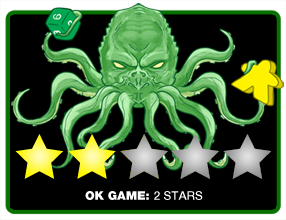 Hits:
Hits:
• (Mostly) Easy to play
• Relaxing at its most-basic level
Misses:
• No logical campaign progression
• Inconsistent rule explanations
• Uninteresting legacy implementation
• No narrative to speak of






















I think the reviewer and I played two different games . I found this game quite lovely and disagree with most of the cons outlines in the summary. It saddens me to see that this review will likely sway people away from experiencing a fun, affordable, relaxing experience.